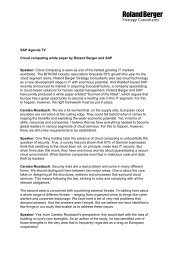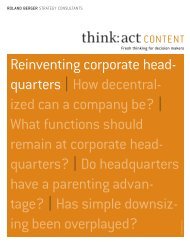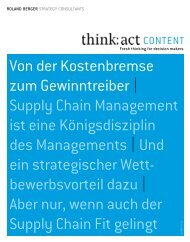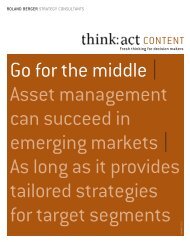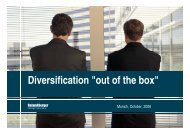Customer-centric retailing â Now you know what ... - Roland Berger
Customer-centric retailing â Now you know what ... - Roland Berger
Customer-centric retailing â Now you know what ... - Roland Berger
You also want an ePaper? Increase the reach of your titles
YUMPU automatically turns print PDFs into web optimized ePapers that Google loves.
CONSUMER GOODS & RETAILConsumer Goods & Retail Competence Center> <strong>Customer</strong>-<strong>centric</strong> <strong>retailing</strong> – <strong>Now</strong> <strong>you</strong> <strong>know</strong> <strong>what</strong> <strong>you</strong>r customers really want
"When our customers change,we change with them."Sir Terry Leahy, CEO of Tesco plc.
Contents3 EditorialJochen Hiemeyer Patrick Müller-Sarmiento Thorsten de Boer4 Relevant trends for Europe'sretailers"Put <strong>you</strong>r customers at the heart of <strong>you</strong>r company."Europe's retailers face major upheavals: an aging population, changing shoppinghabits, fluctuating raw materials prices and declining purchasing power.In short, the customers and their social environment are changing more thanever before.Sir Terry Leahy, chief executive of Tesco, the British supermarket chain, just seesthis as another incentive: "When our customers change, we change with them."However, if <strong>you</strong> really want <strong>you</strong>r company to go down this joint road, it's crucialto have information about <strong>you</strong>r own customers. And there's a lot more to such<strong>know</strong>ledge than last year's sales figures, a bit of market research, and somesociodemographic data. The aim must be to understand the customers'purchasing patterns and needs in their entirety.For many years this was practically impossible. But now there is a tool availablethat can give <strong>you</strong> access to this detailed customer <strong>know</strong>ledge: <strong>Customer</strong>-<strong>centric</strong><strong>retailing</strong> (CCR). You can use CCR to strategically enhance formats and to optimize<strong>you</strong>r range for tactical reasons, as well as in pricing and advertising. Firstof all <strong>you</strong> need clearly defined, homogeneous customer segments. Next, <strong>you</strong>calculate the degree to which each customer segment's sales potential is beingreached and then develop strategies to improve on this result. As a retailer, if<strong>you</strong> understand the needs of <strong>you</strong>r customers better and <strong>know</strong> where there aregaps in <strong>you</strong>r range, <strong>you</strong> can be more targeted and effective when <strong>you</strong> invest inhoning <strong>you</strong>r expertise in the fields of range and pricing.<strong>Roland</strong> <strong>Berger</strong> Strategy Consultants' retail experts have advised many companiesand successfully implemented numerous projects on this subject. Thisbrochure is based on the experience we have gained with these projects. Wewould be delighted to discuss the subject with <strong>you</strong>. Please feel free to writeor to call us. We look forward to <strong>you</strong>r feedback.Jochen Hiemeyer Patrick Müller-Sarmiento Thorsten de BoerPartner Partner Project Manager6 <strong>Customer</strong>-<strong>centric</strong> <strong>retailing</strong>This business approach canincrease the benefits for thecustomer7 CCR: the 8 key steps8 Target-customer segmentation10 An example: Detergents11 Advantages/effects of CCR12 Before and after: A comparison13 Interview with Nitin Sanghavi,Professor of Retail Marketing atManchester Business School16 What other people think:European retailers' experiencewith CCRImpressumPublished by:<strong>Roland</strong> <strong>Berger</strong> Strategy Consultants GmbH,Consumer Goods & Retail Competence CenterMies-van-der-Rohe-Straße 6, 80807 MunichResponsible:Jochen HiemeyerEditors:<strong>Roland</strong> <strong>Berger</strong> EditingStephan Schlote, cintus mediaImages:Mauritius Images, CorbisLa<strong>you</strong>t:RB_DesignTeamPrinted by:Girodruck, Hamburg© only with the publisher's permission3
RETAIL CONSUMER TRENDSConsumers' needs are becoming increasingly diversifiedRetailers need new formats to keep upTHE DEMOGRAPHY AND SOCIAL STRATA OF ALL EURO-PEAN INDUSTRIALIZED NATIONS ARE SHIFTING SUB-STANTIALLY, LEADING TO FUNDAMENTAL CHANGES INTHEIR NEEDS AND PURCHASING PATTERNS. THIS MEANSTHAT IN JUST A FEW YEARS' TIME, MANY RETAILERSWILL NO LONGER RECOGNIZE THEIR OWN CUSTOMERS,BECAUSE THEY WILL HAVE CHANGED SO MUCH – LIKESOCIETY AS A WHOLE.They are not only older, they're also more aware of theenvironment and their health. They live in smaller andsmaller households, want shopping to be easy – avoidingtraveling long distances as much as possible – and areincreasingly interested in products from their own region.They are more individualistic in their lives and purchasinghabits than any generation before them. They want to livehealthily and sustainably, and this doesn't only apply tothe LOHAS (lifestyle of health and sustainability) targetgroup.Others have to budget for every cent and watch pricesmeticulously. Both customer groups are interested ingetting good value for money. And that often also meansthat they prefer to pay a little more for good quality. Themarket is thus becoming increasingly polarized. Althoughmidmarket segments are certainly shrinking, they won'tdisappear completely (despite predictions to the contrary).Instead, we will see increasingly "hybrid" consumptionpatterns with a boom not only in the branded andpremium segments, but also at the lower-priced endof the market.Traditional market research is finding it increasingly difficultto classify these people (and many others) in traditionalsociodemographic terms. Moreover, consumers canno longer be reached as they could in the past due to thefragmentation of the media landscape. Although peopleare watching more television, ratings are falling in individualformats. In the digital future, consumers will be able4
Retail consumer trendsto choose freely <strong>what</strong> they watch and when. Above all,they will be able to fast-forward the advertising if it annoysthem. This means that a company will have to broadcastmany more commercials and advertisements to reachthe same number of customers, and not many can affordto do that.If customers change their attitudes and behavior patternsas radically as this, it will affect retailers more than otherindustries. In saturated markets, the only way to grow is tosqueeze out <strong>you</strong>r competitors, absorb them, or be innovative.Knowing <strong>you</strong>r customers will be a decisive competitiveadvantage in this context.More and more retailers will use this <strong>know</strong>ledge of theircustomers better in future and will serve consumers'wishes with great precision. The aim here is to make eachretail format more attractive to the customer groups ittargets – offering the right range at the right price in theright place. This customer-<strong>centric</strong> <strong>retailing</strong> will put customerrelations on a completely new footing.But not only retailers' relationship with their customers willchange; relations with suppliers will also be transformed.Suppliers – especially "category captains" – currently havea considerable advantage over retailers when it comes totheir <strong>know</strong>ledge of customers. With CCR, retailers can turnthis deficit into a competitive advantage. They can pick updetailed information – for example on how product launchesare received by customers, and <strong>what</strong> effect marketingprograms and pricing strategies have – not on all customers,but broken down into individual customer groups.Retailers will be able to greatly strengthen their positionin this way.More about this on the following pages.5
CUSTOMER-CENTRIC RETAILINGThis business approach can increase thebenefits for the customerActually it doesn't. Because the reality in <strong>retailing</strong> isusually different. The range is still excessively dominatedby the traditional supplier orientation, with retailers concentratingon quantity, turnover and sales. They assumethat cheap is <strong>what</strong> sells, so one campaign follows another.They advertise <strong>what</strong> their buyers can get onto the shelvesat the biggest discount. However, this has little to do withbeing truly customer-oriented.The person who really <strong>know</strong>s <strong>what</strong> the customers wantis the independent shopkeeper, since he spends enoughtime in his shop and with the customers. Large retailgroups can only guess at best: they tend to be quitecentralized and are far away from customers when theytake decisions about ranges, prices and positioning.OF COURSE, EVERYONE SAYS THE CUSTOMER IS KING.BUT IN REALITY THINGS LOOK QUITE DIFFERENT. NOWTHERE IS A TRIED-AND-TESTED METHOD THAT REALLYDOES FOCUS ON THE CUSTOMER: CUSTOMER-CENTRICRETAILING. FOR THE FIRST TIME THERE IS A SYSTEMTHAT ALIGNS THE MARKETING MIX (RANGE, CUSTOMERSERVICE, PRICE AND PROMOTIONS) TO THE CUSTOM-ERS' NEEDS. BUT THERE'S MORE TO IT THAN THAT:IF YOU REALLY WANT TO BE DRIVEN BY WHAT YOURCUSTOMERS WANT, YOU HAVE TO REDEFINE YOURBUSINESS.This store seems to have everything: 80,000 productsacross all food and non-food categories covering well over100,000 square feet of floor space. The range of itemsoffered almost overwhelms <strong>you</strong> when <strong>you</strong> enter this giantshopping temple. If <strong>you</strong> can't find <strong>what</strong> <strong>you</strong> want here, <strong>you</strong>won't find it anywhere. Because this store seems to haveeverything customers want. Or does it?Most major retailers typically have huge amounts of dataat their disposal, regularly engage in market research,often issue loyalty cards, and also have access to precisedaily sales data. Yet they rarely read all this data in anoverall context. If customers are analyzed at all, it is invague sociodemographic terms, and perhaps revenuesand discounted sales figures are compared with thoseof previous years. But these retailers have no idea whobought <strong>what</strong>, when and why."If <strong>you</strong> don't <strong>know</strong> where <strong>you</strong>r customers are going, <strong>you</strong>'llget left behind," says retail expert Professor Nitin Sanghavi(see interview on p. 13) from Manchester BusinessSchool. Classic mom-and-pop stores used to <strong>know</strong> theircustomers personally. So should we go back to the traditionalcorner store? Hardly. So is there any way of combiningthe grocer's closeness to his customers with therange and efficiency of centrally managed retail systems?Doesn't size and centralization always lead to beingremote from the customer?There is a solution to a lack of <strong>know</strong>ledge of <strong>you</strong>r customers:the loyalty card, debit card or credit card. Thedata that is analyzed is not the customers' personal data.Instead, sanitized purchasing data is used to form groupsof customers with similar purchasing patterns (e.g.6
CUSTOMER-CENTRIC RETAILING2. Create store clustersThe next step is to create clusters of stores to make themeasier to manage according to their individual needs andspecial characteristics. The criteria on which decisions arebased should no longer be the region, store size or position,but each store's customer-segment profile. Andthese can differ considerably.In one of our customer projects, we distinguished betweeneconomy, standard and premium stores. In an area wherethe customers were most interested in buying at discountprices, more space was devoted to the entry-level pricerange and the retailer's own brands. However, at locationswith an above-average percentage of consumers withhigher incomes who like to buy higher quality food, theproportion of premium products was significantly increased,particularly in categories such as wine andfresh foods.Of course, varying the range of products offered accordingto store clusters involves more organizational work: forexample, <strong>you</strong> have to create and update different planograms.However, the marked increase in customer satisfactiontranslates into a considerable economic benefit forthe retailer.3. Define <strong>you</strong>r target-customer segmentsBig retail groups try to satisfy practically every customer.No customer group can be neglected. Even so, they tooshould focus on strategic and high-value target-customersegments. Competition in the retail trade is growing all thetime, and the battle for customers is getting fiercer. Theresult is a further differentiation of formats. In food <strong>retailing</strong>,for example, this makes it possible to cater for specificcustomer needs in a more focused way; at least that is theaim of organic supermarkets, city-center stores and conveniencestores. Which makes it all the more importantfor <strong>you</strong> to keep <strong>you</strong>r customers loyal, raise <strong>you</strong>r "share ofwallet" and attract new customers. You will only succeedin this if <strong>you</strong> are constantly working on <strong>you</strong>r efficiency andmake <strong>you</strong>r format more attractive to <strong>you</strong>r target customers.CCR can help here, because the better <strong>you</strong> as a retailerunderstand the desires and needs of <strong>you</strong>r target customers,the more precisely and more efficiently <strong>you</strong> will beable to invest. In the same way, CCR reveals the productcategories in which <strong>you</strong> need to improve to satisfy thedifferent customer groups. To give <strong>you</strong> an example, in onecustomer project we found out that the members of the"convenience buyer" customer group were buying a significantlylower proportion of frozen products than from8
<strong>Customer</strong>-<strong>centric</strong> <strong>retailing</strong>relevant competitors. More detailed analysis revealedthat both the available product selection and the pricepositioning were suboptimal. This gap was quickly closedon the basis of the CCR approach, and the customersresponded positively.Such an approach can be used to deduce differentiatedstrategies for each customer group, the essential aimbeing to give the customers more added value by offeringmore attractive ranges and services and an improvedpricing policy.4. Align <strong>you</strong>r product category strategyOnce <strong>you</strong>'ve defined <strong>you</strong>r target-customer segments andstore clusters, the next step is to define <strong>you</strong>r strategicguidelines, category role, target-customer segments, etc.,for each category. It's best to start with a detailed analysisof the market position and the importance of the productcategory in the overall range. The next step is to determinethe product category's performance – compared to themarket and leading competitors, as well as from the pointof view of consumers. Based on the optimization potential<strong>you</strong> identify, <strong>you</strong> can then decide which customer segmentsto target in future and which ranges/products,prices and promotions to consider.5. Optimize <strong>you</strong>r rangeYour next aim is to provide a range of products that is asattractive as possible for the defined target-customersegments. To do this, <strong>you</strong> must find out which customersprefer which items, how loyal they are to these products,and how many buyers are reached by the individual products.The "RB Category Optimizer" is used to create adecision tree showing purchase decisions for each customersegment and product category. It reveals the logicfollowed by the customers when they are in the store –right down to their purchasing patterns at the shelves.This allows conclusions to be drawn for a more customerfriendlyproduct chronology and better merchandising.Optimizing <strong>you</strong>r range from the customer's perspective:Here is an example from the field of detergents. The laundrydetergent products (page 10, photo on the left) arearranged according to the traditional industry-dominatedshelf system – by brand and package size. As a result,the arrangement is not governed by how customers tendto buy. Products that customers feel belong together arearranged separately; the shelves offer little in the wayof orientation.The photograph on the right shows how customers wouldset out a shelf of laundry detergent products. The newla<strong>you</strong>t reflects how people actually buy: this is why, inthis case, products that customers think of as belongingtogether are placed next to each other on the shelves.Here we have copied the customer's first purchasedecision and separated liquid detergents from powderdetergents. We have also created vertical brand blocksto improve orientation.Today, decisions on inclusion and exclusion are stillvery much based on lists of fast and slow sellers andthe subsidies for advertising provided by manufacturers.However, such data does not give any indication of howimportant certain products are to individual customergroups. For example, although a high-quality skin creammight not be purchased very often, it could neverthelessbe an important product for the "conservative and brandconscious"customer segment. If <strong>you</strong> want to boost theloyalty of this customer group in the field of personalhygiene, <strong>you</strong> need to understand exactly which productshave a positive impact on customer satisfaction, whichproducts can be dispensed with, and whether there areany product gaps on the shelves.6. Optimize <strong>you</strong>r pricing strategyHow can <strong>you</strong> optimize <strong>you</strong>r pricing strategy based on abetter understanding of <strong>you</strong>r customers? As a general rule,food retailers tend to match their competitors' prices fortheir best-selling products with the aim of improving theirprice image among the customers. This "watering can"approach is a waste of margins because it involvesinvesting indiscriminately in the prices.9
CUSTOMER-CENTRIC RETAILINGCCR in practice: Laundry detergents on the shelves– before ... ... and afterBy contrast, CCR is a customer-segment-specificapproach. Specific baskets of goods are determined foreach customer segment using indicators (e.g. indexedcustomer reach, loyalty). The prices of these basketsare then compared with those of relevant competitors.A differentiated pricing strategy can now be defined foreach customer segment according to each segment'sprice sensitivity.Price suggestions are determined at the product andproduct-category levels on the basis of information onsensitivity, margins and cross-purchasing. For this weuse tried-and-tested algorithms. The results are reviewedand released by category management.This superior understanding of customers can be usedas a basis for targeted investment in prices – and simultaneouslyto manage the price image.7. Improve the effectiveness of <strong>you</strong>r promotionalbusiness/direct marketingThis new way of thinking in customer segments and targetgroups also changes promotional business, which isimportant for customer footfall. Up to now, the productschosen for campaigns have depended very much on <strong>what</strong>share of advertising costs was picked up by the industry.<strong>Now</strong>, for the first time, offers can be tailored to targetgroups and timed according to the consumption patternsof the individual customer segments.At last, retailers receive direct feedback on their advertisingspend and how successful it has been in each targetsegment. The aim of optimization is to select products insuch a way as to advertise those that are simultaneouslythe most attractive and the most profitable products atthe right moment. This makes it possible to significantlyimprove the design of promotional leaflets in terms ofdistribution, number printed, products chosen andpictures used.For example, <strong>you</strong> can only tempt the so-called "smartshopper" segment with brand-name candy at the beginningof the month. By the end of the month, this segment(which otherwise generates high sales) has run out ofcash. The number of confectionery products in the leafletcan thus be reduced late in the month.CCR can also improve the efficiency of direct customercontact via the Internet or mailings. Campaigns, customerinformation or specific service offers that are tailored toa target group can increase footfall and sales; they havealso been proven to boost customer satisfaction.10
<strong>Customer</strong>-<strong>centric</strong> <strong>retailing</strong>8. Implement a change-management process<strong>Customer</strong>-<strong>centric</strong> <strong>retailing</strong> is far more than just a new wayof optimizing <strong>you</strong>r range, however. When properly thoughtthrough, it's a holistic management approach involvingall company divisions. The successful implementation ofcustomer-<strong>centric</strong> <strong>retailing</strong> requires a systematic changemanagementprocess.Processes and controlling systems must be adjusted tothe CCR logic. If <strong>you</strong> want to bring the daily activities of<strong>you</strong>r employees into line with this way of thinking, <strong>you</strong>must also integrate customer-centered objectives intothe staff MbO system.<strong>Roland</strong> <strong>Berger</strong>'s team of retail experts have already provenmany times that CCR works. And <strong>what</strong> is probably one ofthe most successful retail groups in the world startedusing CCR years ago to put the focus on the customer."We grow by understanding our customers,"says Sir Terry Leahy, chief executive of Tesco."When they change, we change with them."And it really is worth it (see boxes below):> Retailers are freed from the shelf dominanceof industry> Investments in range and prices are easier to measureand can be used in a more targeted fashion> Sales, retail margins and customer loyalty increaseas a result of greater customer acceptanceBut it doesn't stop there. Because all retail groups canmarket the data they have on the shopping patterns oftheir customer groups (not their customers) to industryin strictly sanitized form. This does not breach any dataprotection rules, hurts no one, and benefits retailers andindustry alike. In <strong>you</strong>r negotiations with suppliers, <strong>you</strong> asa retailer can look them straight in the eye when it comesto <strong>know</strong>ledge of consumers and shopping patterns. Forexample, <strong>you</strong> can inform suppliers about how customersmake their choices at the shelf and how popular newproducts are. <strong>Customer</strong>-<strong>centric</strong> <strong>retailing</strong> thus generatesadded value for everyone.ADVANTAGES FOR RETAILERS> Get a better understanding of the shoppingpatterns and needs of different customersegments> Raise the profile of the retail format> Improve <strong>you</strong>r range expertise whilesimultaneously streamlining the range –without losing sales> Improve price image> Make promotional business more efficient> Improve customer satisfaction/loyalty> Improve customer-retention programECONOMIC EFFECTSImprovement in the retail margin (%) 1)> Improved pricing 0.4 – 0.6> Optimized promotion campaigns 0.5 – 0.7> Optimized range/merchandising 0.5 – 0.7> Overall effect 1.4 – 2.01) Based on experience with <strong>Roland</strong> <strong>Berger</strong> projects11
CUSTOMER-CENTRIC RETAILINGHOW CUSTOMER-CENTRIC RETAILING CAN CHANGE YOUR BUSINESSBEFOREAFTERUNDERSTANDINGTHE CUSTOMERRANGEMANAGEMENTPRICEMANAGEMENTPROMOTIONALBUSINESS/MARKETING/DIRECT MARKETINGMANAGEMENTMANAGEMENTLittle understanding of the customerstructures, purchasing patterns or needs.If customer segmentation exists at all, it isprimarily based on sociodemographic data.Range decisions are based primarily onclassic indicators such as sales revenues,sales volumes and customer reach.Traditional price strategy: decisions areclearly focused on top-selling items acrossall categories; competitors' prices arematched.Selection of products for advertisingcampaigns and promotions is very muchindustry-driven. Internal management isprimarily geared to revenue and volumetargets. Specific customer interests arehardly taken into account.Purchasing, category management, salesand marketing use different KPIs, some ofwhich are not properly integrated. Marketingand consumer research do not interactwith category management.Clearly defined customer segmentationbased on actual purchasing patterns.Clear idea of which customer segmentbuys <strong>what</strong>, when and why.Range decisions and merchandisingare consistently geared toward customerneeds. Decisions on product chronology,shelf arrangement, listing and de-listingare based on quantifiable customerbehavior patterns.Pricing decisions are made on the basisof quantitative analysis. Pricing is basedon baskets of goods for specific customersegments, their competitive price indices,and the customer segments' price sensitivities.Promotional products are consistentlygeared to the target-customer segments –this can significantly improve the attractivenessand profitability of promotionalbusiness.<strong>Customer</strong>-related targets are definedalong the entire value chain; customerbehavior patterns are systematicallyassessed; the effectiveness of the rangeand processes is improved to the benefitof target customers.12
PROF. NITIN SANGHAVIINTERVIEW<strong>Customer</strong>-<strong>centric</strong> <strong>retailing</strong>"The majority of retailers have not grasped thestory yet. They still lose sight of the customer."Nitin Sanghavi, Professor of Retail Marketing and Strategyat Manchester Business School.Prof. Sanghavi, could <strong>you</strong> please outline some of thekey trends in the European retail industry?We currently see a fundamental change in the consumermarkets. There is a shift taking place in consumer shoppingattitudes and buying behavior patterns. Consumersare becoming much more concerned about spending. Inaddition, we have to face some fundamental demographicand socioeconomic changes. Furthermore, the industryhas to deal with rising cost pressure. Retail prices aresuffering from stagflation or deflation in many productcategories. In this market situation it is very difficult toraise the prices and sustain them in response to increasingcosts. We have a very high level of ambiguity, uncertaintyand complexity among consumers and the markets.We have never faced a situation with a dynamic momentumlike this before.Offerings are managed in the stores using out-of-datemetrics, and nobody understands <strong>what</strong> sort of productsor services customers really want. Right or wrong?Yes, absolutely right. Many retailers have lost sight of thecustomer. They act without thinking about the customer.For categories, they think too much about sales volume,sales revenues and suppliers instead of understandingthe customers and specifically targeting them. Categorymanagement is all about defining ranges, recording allrelevant metrics on a category scorecard, organizationalskills, information technology and the relationship betweenmanufacturers and retailers. These elements need tobe aligned to the consumer. If they are not, in other wordsif there is no customer focus and no real understandingof the customer, then category management cannot beeffectively used as a tool.What's the conclusion of this? What kind of transformationdo <strong>you</strong> expect for the retail industry?This extremely harsh climate will leave its mark; retailerswill have to change and adapt. We will get much moreconsolidation in the marketplace compared to <strong>what</strong> wehave seen before. The number of players will disappearor will have to consolidate. At the end of the day, theconsumers will have access to a decreasing numberof retail brands.I would like to challenge <strong>you</strong> with the following theoryof European retail management: Traditional categorymanagement dominates; the industry is increasinglyrelying on volumes, sales, terms and promotional rebates.There is hardly any real focus on the customer.Nitin Sanghavi has been Professor of Retail Marketingand Strategy at Manchester Business School (MBS)since 1985, after holding senior positions for a numberof major retail and retail-related organizations in theUK and overseas. He is a frequent speaker at nationaland international retail conferences. He also acts asa non-executive director for several retail and retailrelatedorganizations in Europe and India.13
PROF. NITIN SANGHAVIINTERVIEWThe philosophy of customer <strong>centric</strong> <strong>retailing</strong> has beenestablished since the early nineties. Nearly every retailcompany uses loyalty cards. However, few retailersreally use the data provided by those cards. Why is that?Many retailers just have a loyalty card scheme and thedata from it and do not <strong>know</strong> <strong>what</strong> to do with it. So theyend up with purely superficial information but do not gainany insight relevant to strategic alignment and operations.Companies have to work out the right actions that willenable them to achieve the required returns on thecapital employed.So <strong>what</strong> needs to happen?My advice to those who are serious about customer <strong>centric</strong>ityis quite straightforward: You start with the customer,<strong>you</strong> end with the customer. Tesco aligns all its key decisionsinvolving the product range, pricing, store la<strong>you</strong>t,design, branding and local marketing with its customerfocus. However, it took Tesco a good deal of time to finallyunderstand the idea of consumer <strong>centric</strong>ity and how to getclose to the customer. Once understood, they re-alignedtheir business, core purpose, values, proposition, people,processes and systems. So it's about understanding theissue and changing <strong>you</strong>r mind set. And this is hard work.It took Tesco almost seven years to change the mindsetthroughout the business. This is a long-term process andvery few retailers have the patience and perseverance torun through this process.It is a process that affects the entire company.Yes, it has to be supported by the CEO as well as by theentire organization – and everybody needs to talk the talkand walk the talk everyday with sincerity. This is a majorchange process which contains much more than one mightexpect. Today we use Tesco as an example for best practicein customer <strong>centric</strong>ity but at the same time its achievementsalso make us understand how difficult it is toimplement these changes. Many retailers drop out of thisproject because they don't expect all these hurdles. Theysimply underestimate the challenge and fail to align theentire organization, including its people, processes andsystems behind it.Can <strong>you</strong> give us some more best-practice examples?Sure. One is the US chain Best Buy, today's globally leadingelectronic retailer. They really understand their customers,talk to them and continuously align their businessin line with the changing customer needs and expectations.Costco also has done a great piece of work in thisarea, together with the supermarket chain H.E.B. basedin Texas and Mexico. Their motto is "He profits most whoserves best". They are all extremely consumer-focused.And also people talk about Nordstrom, a leading fashionspecialty retailer in the US that is also very customer<strong>centric</strong>.Coming back to the retail industry as a whole, wheredo <strong>you</strong> see the future key fields for competition?One key subject is to understand the customer and customer-levelprofitability. For this, we have to get muchcloser to the customer than where we are today. We have toprovide more value for money, and this means "Price plus".Many customers want a good price but this is not enoughto satisfy them, as many of them are also looking forreasonable service, choice, quality, etc. Retailers need totake this message on board to help them differentiate anddevelop compelling competitive advantage. Another keyfield is the so-called financial viability of a retailer in termsof cash generation and cost control – especially in timesof high volatility, stagnant or falling sales and rising costs.So even in this difficult economic climate <strong>you</strong> wouldnot suggest over-estimating the price sensitivity?Sure, going forward, there will be greater price sensitivityfrom consumers. A few more customers may switch to thediscounters and low-price retailers with whom they havenot shopped before for all or some of their needs. Whatwe haven't seen is a mass exodus towards the discountersonly because of the price issue. And if we look at retailerssuch as Aldi in the UK, we see that in the beginning theywere completely focused on the price and finally realizedthat people were looking for "price plus". The price isimportant, but it is not everything. Just as an example:when we set price in relation to quality, I would say this isaround a 60:40 ratio. However, it is important to keep <strong>you</strong>r14
Intervieweyes on sudden shifts in competitive price structure. Anothertrend we might see will be the higher sales of stores'own brands in several categories and subcategories at theexpense of branded goods as consumers look for morevalue for money.But many people have to manage their lives with smallbudgets.Yes, but very few customers are completely price-driven.Tesco, for example, realized that their customers asked forvalue for money and for quality and reasonable service.So they offered a certain range of products which are nowavailable at a very low price and are very comparable todiscounters. The message to the customer is: we are not adiscounter, but <strong>you</strong> don't need to go to the discounter anymore. Here <strong>you</strong> get both worlds in one. This is working outvery well for them.<strong>Customer</strong> <strong>centric</strong>ity must be aligned to the whole companyand embedded in the core processes of sourcing, logistics,category management, merchandising, sales and marketing.And this mindset must be incorporated into the managementsystem and corporate culture. <strong>Customer</strong>-<strong>centric</strong> <strong>retailing</strong> is acorporate philosophy and should thus be part of the long-termcorporate strategy.At the same time, retailers must constantly work on the efficiencyof their retail system without neglecting differentiation.To do this, all potential, from sourcing to logistics to storeoperations, must be identified and realized. And retailers needthe courage to take new paths and change things. So theyshould always look for examples of best practice in order tolearn from them and become better, faster and more efficient.Coming to a conclusion – do <strong>you</strong> have any advice forthe industry?I can see four key points. Retailers should concentrateon providing and selling more value. To do so, they need toget closer to their customers and understand their needstoday and tomorrow. Thinking in customer segments isincreasingly critical to success.Especially in saturated markets, retailers need to leverageproven marketing and format channels. By identifying andaddressing specific customer needs, they can create additionalareas of growth. One example of this is Auchan'sdrive-through supermarket that exclusively targets a mobilecustomer group. Around 6,000 products are on offer thatcan be bought at a terminal. The products are then directlyloaded into the back of the customer's car.15
WHAT DO YOU THINK?How leading retailers view their customers.HOW DO LEADING RETAIL CHAINS HANDLE CUSTOMER ORIENTATION?WE ASKED TOP MANAGERS AT CARREFOUR, DM AND KONZUM.Thierry AfriganDirector of <strong>Customer</strong>Marketing – CRM GroupeCarrefourWhat does customer <strong>centric</strong> <strong>retailing</strong> mean for Carrefour?At Carrefour, we have an ambition: to become the preferred retailer. Thismeans we want to delight our customers and improve their quality of life,wherever we encounter them. We therefore need to <strong>know</strong> them better to servethem better. We decided to deepen our <strong>know</strong>ledge about our customers byanalyzing all the data we collect from our checkouts through the loyalty cards.We can therefore adjust our entire offering, i.e. store la<strong>you</strong>t, products, merchandising,prices and promotions, to suit our customers' needs even better.This is a major lever that we use to push Carrefour's image and make it moreattractive to customers.How did Carrefour implement CCR?We started by segmenting the customers. Today, for each segment, we cantrack exactly how footfall, average receipts and purchasing behavior havedeveloped in each of the various product categories. So we can set up theproduct assortment strategies accordingly. This is usually an annual process.We also apply CCR tactically in category management for making decisionson la<strong>you</strong>t, product, price or sales promotions.With CSD® for Carrefour Shopper Discover, the name of our CCR approach,we have a consistent platform today. Purchasing/category management,marketing and sales follow the same logic, i.e. customer segmentation,strategies for target customers and product groups, as well as KPIs.This way, we can zero in on our customers even better.Has CCR already been rolled out internationally as well?Carrefour deployed CSD® in the biggest markets in which it operates withloyalty schemes and it is becoming more and more embedded in the organizationalstructure. France and Spain are setting the pace, and since the endof 2009 we have begun to share our customer <strong>know</strong>ledge approach with oursuppliers by launching Joint Shopper Discovery® through Emnos, a companyspecialized in customer <strong>know</strong>ledge management. We believe that sharing acommon understanding of our customer needs and potential with our suppliersis key for jointly profitable growth.16
CEO statementsErich Harsch,CEO of dm, the Germandrugstore chainWhat does customer orientation mean for dm?"The first consequence of customer orientation for us is that we communicatedifferently. dm doesn't try to lure or tempt customers, but to inform them.This is why we don't run any broad-based promotion or brochure campaignsadvertising a cross-section of our range every week. That would be wateringcanmarketing and has nothing to do with target-group orientation. Instead,we try as direct an approach as possible. Regular mailings are therefore keytools for us in our marketing. We send out about 30 million letters to ourcustomers in the course of a year. As far as possible, these relate to eachcustomer's interests, as expressed in their purchasing patterns. Of course,our dm payback customer card plays an important role in this context; half ofour customers are already benefitting from it. In these mailings we are alwayslooking for special topics that match the respective target group, e.g. informationon dental care for people with false teeth, cosmetics, the whole range ofbaby products, or health foods. We always try to address our customers inas targeted a way as possible."How does <strong>you</strong>r company practice customer orientation?"Three further points are equally important to a customer focus: stores, staffand price. As our founder Götz W. Werner says, the store is the product. It's thedecisive interface between the retailer and the consumer. Every store musttherefore be in the best possible condition. The success of a store dependsin turn on the staff who work there. This is a key issue for us. At dm there is nocommand or monitoring system, as is often the case among other franchiseretailers. This means that store managers – and individual shop assistants forthat matter – have much greater discretionary powers and scope for individualcreativity. The teams themselves coordinate who does <strong>what</strong> and when. Thisalso applies to the details of the product range, which is ultimately the responsibilityof the respective staff member. We avoid dictating centrally. Thesentence "retail is detail" is correct. As for prices, we are extremely successfulwith our stable-price concept. We charge up to 15 percent less for a basket ofgoods than our competitors. Offering good prices is therefore another importantpoint when it comes to customer orientation. Our customers agree withus on all this. That is why dm is also always way ahead in surveys of customersatisfaction conducted by Kundenmonitor in Germany."
Darko Knez,member of themanagement ofKonzum, CroatiaHow important is the Konzum Plus Card for the company?"Konzum unequivocally gears its business toward its customers. The KonzumPlus Card is a key tool here. This card has been extremely well received:almost three quarters of our customers prefer the Plus Card to other loyaltyprograms. In addition to this customer-retention effect, we can use theprogram to gather valuable information."A customer card alone is not enough. In <strong>what</strong> other ways do <strong>you</strong> gearKonzum to the customer?"The carefully analyzed customer data helps us to build an organization thatserves our customers best. For example, we have developed a marketing andsales strategy that puts the customer absolutely at the center of attention.<strong>Customer</strong> orientation is also the watchword in areas such as store-spacemanagement and category management. The range offered in the storestherefore depends on <strong>what</strong> the customers in the respective catchment areaswant. In addition to segmenting them by size, we categorize the stores asPremium, Standard and Economy according to their customers' preferences.This grouping of stores is based on our customer segmentation using thecustomer information we collect via the loyalty card. When more people withhigher incomes live in a store's catchment area, the range shifts more towardpremium, e.g. by including a broader selection of wines and other premiumproducts. However, if the area is one where it's more important for customersto buy large quantities at discount prices, we adjust the store's range to thispreference. <strong>Customer</strong> information is also used in price management. It helpsus to close gaps in the range and to identify critical price thresholds from thecustomer's perspective. It also makes an important contribution to directmarketingcampaigns and offers valuable potential for the further expansionof business relations with our trading partners."18
THE CONSUMER GOODS & RETAIL COMPETENCE CENTERAT ROLAND BERGER STRATEGY CONSULTANTSConsumer Goods & Retail is internationally structured and one of the major consulting divisionsat <strong>Roland</strong> <strong>Berger</strong> Strategy Consultants. Around 130 consultants work for this Competence Centerworldwide. Independent market studies regularly give us an above-average rating. In Europe, ourconsumer goods & retail clients rank us number one.We advise retailers on the following topics (selection):> Realigning the corporate strategy> Developing and refining format concepts> Adapting customer-<strong>centric</strong> <strong>retailing</strong> to a specific company> Optimizing range and pricing strategies> Improving the efficiency of promotional business> Optimizing purchasing strategy and processes> Optimizing supply-chain strategy and processes> Implementing restructuring and efficiency-improvement programs> Supporting M&A and post-merger integrationCONTACTFranceOlivier de PanafieuPhone: +33 1 53670-908Olivier_dePanafieu@fr.rolandberger.comUKTim ManassehPhone: +44 20 30751-118Tim_Manasseh@uk.rolandberger.comItalyPierpaolo MamonePhone: +39 06 424-561Pierpaolo_Mamone@it.rolandberger.comNetherlandsAlexander BelderokPhone: +31 20 7960-641Alexander_Belderok@nl.rolandberger.comSpain / PortugalAntonio BernardoPhone: +351 21 3567-601Antonio_Bernardo@pt.rolandberger.comRussiaOlga SagirovaPhone: +7 495 28792-46Olga_Sagirova@ru.rolandberger.comPolandKrzysztof BadowskiPhone: +48 22 32374-14Krzysztof_Badowski@pl.rolandberger.comCroatia, Serbia, SloveniaVladimir PrevedenPhone: +385 1 4804-840Vladimir_Preveden@at.rolandberger.com
AmsterdamBahrainBarcelonaBeijingBerlinBrusselsBucharestBudapestCasablancaChicagoDetroitDüsseldorfFrankfurtHamburgHong KongIstanbulKyivLisbonLondonMadridMilanMoscowMunichNew YorkParisPragueRigaRomeSão PauloShanghaiStuttgartTokyoViennaWarsawZagrebZurich© 2010 <strong>Roland</strong> <strong>Berger</strong> Strategy ConsultantsAll rights reservedwww.rolandberger.com




